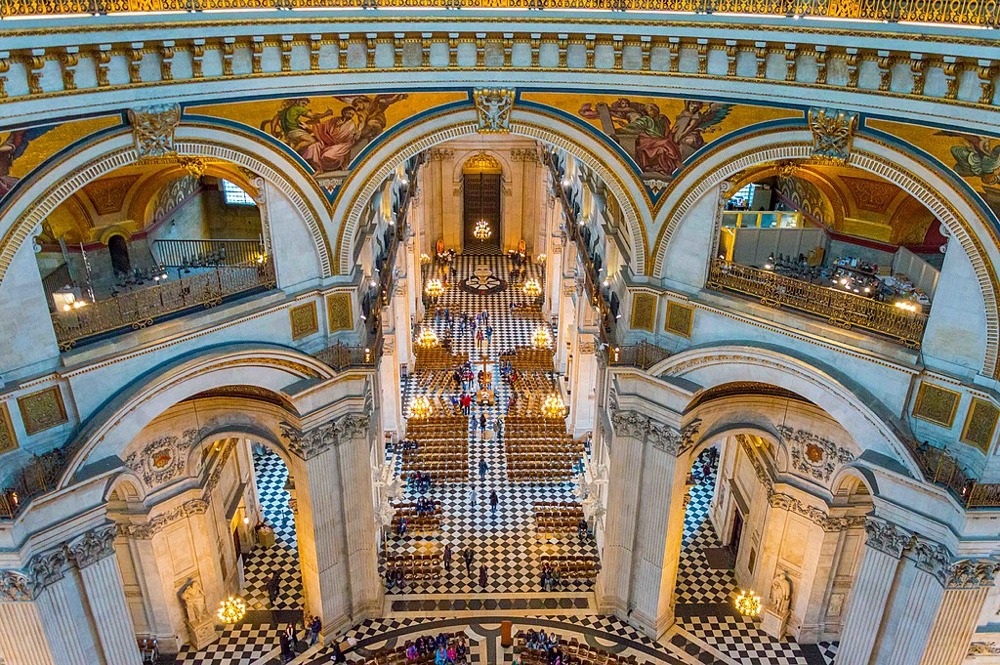St Paul's Cathedral Whispering Gallery
Home > Photos from England > St. Pauls Cathedral > St Paul's Cathedral Whispering Gallery

This is a photograph of the so called whispering gallery beneath the dome of St Paul's Cathedral in London, England looking toward the nave and the west entrance.
This photograph is licensed under the Creative Commons Attribution-Share Alike 2.0 license. Author: D Iliff. It has been modified to have a vertical pixel count of 1000.
Dome
The interior of the dome shows how Thornhill's painting continues an illusion of the real architectural features. This view of an arch spanning the aisle shows how Wren succeeded in giving an impression of eight equal arches.
The main internal space of the cathedral is under the central dome which extends the full width of the nave and aisles. The dome is supported on pendentives rising between eight arches spanning the nave, choir, transepts, and aisles. The eight piers that carry them are not evenly spaced. Wren has maintained an appearance of eight equal spans by inserting segmental arches to carry galleries across the ends of the aisles and has extended the mouldings of the upper arch to appear equal to the wider arches.
Above the keystones of the arches, at 99 feet (30 m) above the floor and 112 feet (34 m) wide, runs a cornice that supports the Whispering Gallery so called because of its acoustic properties: a whisper or low murmur against its wall at any point is audible to a listener with an ear held to the wall at any other point around the gallery. It is reached by 259 steps from ground level.
The dome is raised on a tall drum surrounded by pilasters and pierced with windows in groups of three, separated by eight gilded niches containing statues, and repeating the pattern of the peristyle on the exterior. The dome rises above a gilded cornice from 173 feet (53 m) to a height of 214 feet (65 m). Its painted decoration by Sir James Thornhill shows eight scenes from the life of St Paul set in illusionistic architecture which continues the forms of the eight niches of the drum. At the apex of the dome is an oculus inspired by that of the Pantheon in Rome. Through this hole can be seen the decorated inner surface of the cone which supports the lantern. This upper space is lit by the light wells in the outer dome and openings in the brick cone. Engravings of Thornhill's paintings were published in 1720.
Nave
The nave (/neɪv/) is the central part of a church, stretching from the (normally western) main entrance or rear wall, to the transepts, or in a church without transepts, to the chancel. When a church contains side aisles, as in a basilica-type building, the strict definition of the term "nave" is restricted to the central aisle. In a broader, more colloquial sense, the nave includes all areas available for the lay worshippers, including the side aisles and transepts. Either way, the nave is distinct from the area reserved for the choir and clergy.
Description
The nave extends from the entry — which may have a separate vestibule (the narthex) — to the chancel and may be flanked by lower side aisles separated from the nave by an arcade. If the aisles are high and of a width comparable to the central nave, the structure is sometimes said to have three naves. It provides the central approach to the high altar.
St Paul's Cathedral
St Paul's Cathedral is an Anglican cathedral in London and is the seat of the Bishop of London. The cathedral serves as the mother church of the Diocese of London. It is on Ludgate Hill at the highest point of the City of London and is a Grade I listed building. Its dedication to Paul the Apostle dates back to the original church on this site, founded in AD 604. The present structure, dating from the late 17th century, was designed in the English Baroque style by Sir Christopher Wren. Its construction, completed in Wren's lifetime, was part of a major rebuilding programme in the city after the Great Fire of London. The earlier Gothic cathedral (Old St Paul's Cathedral), largely destroyed in the Great Fire, was a central focus for medieval and early modern London, including Paul's walk and St Paul's Churchyard, being the site of St. Paul's Cross.
The cathedral is one of the most famous and recognisable sights in London. Its dome, surrounded by the spires of Wren's City churches, has dominated the skyline for over 300 years. At 365 ft (111 m) high, it was the tallest building in London from 1710 to 1963. The dome is still one of the highest in the world. St Paul's is the second-largest church building in area in the United Kingdom, after Liverpool Cathedral.
Services held at St Paul's have included the funerals of Admiral Lord Nelson, the Duke of Wellington, Winston Churchill, and Margaret Thatcher; jubilee celebrations for Queen Victoria; an inauguration service for the Metropolitan Hospital Sunday Fund; peace services marking the end of the First and Second World Wars; the wedding of Prince Charles and Lady Diana Spencer; the launch of the Festival of Britain; and the thanksgiving services for the Silver, Golden, Diamond, and Platinum Jubilees and the 80th and 90th birthdays of Queen Elizabeth II. St Paul's Cathedral is the central subject of much promotional material and images of the dome surrounded by the smoke and fire of the Blitz. The cathedral is a working church with hourly prayer and daily services. The tourist entry fee at the door is £21 for adults (Summer 2022, cheaper if booked online), but no charges are made to worshippers attending advertised services.
The nearest underground station is St Paul's, which is 130 yards (120 m) away from St Paul's Cathedral.
From Wikipedia, the free encyclopedia.


